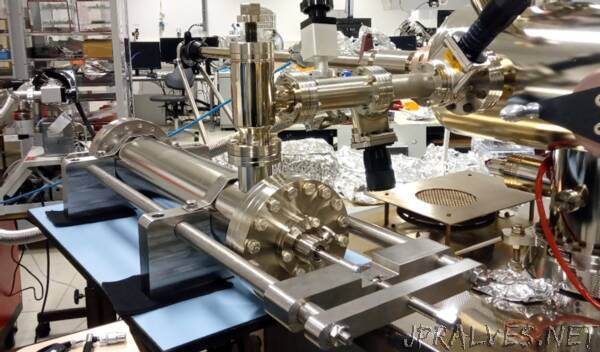
“A pretty special gift unwrapping will soon take place – a piercing tool built by ESA will open a Moon soil container from Apollo 17 that has gone untouched for nearly 50 years. The opening will allow the extraction of precious lunar gases which may have been preserved in the sample.
Analysis of the gaseous volatiles will allow scientists to better understand the geology of the Moon and help engineers to design better sampling tools and techniques for future missions to the Moon or even Mars.
The gas extraction experiment is part of the larger Apollo Next-Generation Sample Analysis (ANGSA) programme that coordinates the analysis of pristine Moon samples from the Apollo era. And for the first time ever, ESA is involved in the opening of soil returned from the Moon.
“The opening and analyses of these samples now, with the technical advancements achieved since the Apollo era, can enable new scientific discoveries on the Moon. This can also inspire and inform a new generation of explorers,” says Francesca McDonald, science and project lead of ESA’s contribution to ANGSA.
Francesca and colleague Timon Schild travelled last month to NASA’s Johnson Space Center in Houston, USA, to deliver the piercing tool and train the lunar sample curation team on how to operate it.
“It is a privilege to be able to work amongst the treasure trove of ancient Moon samples that have witnessed the history of our Solar System, and be a part of a programme that can help to reveal their secrets,” adds Francesca.
The tool now stands-by to be used on the Apollo sample container in the coming weeks.
Lunar origins
Astronaut Gene Cernan collected the sample on the Moon in 1972 from a landslip deposit that cascaded down into the Taurus-Littrow Valley. The Apollo 17 astronaut hammered a 70 cm long cylindrical tube into the surface to extract a core sample of the lunar soil.
The lower half of this core sample was sealed in a vacuum tight container on the lunar surface. Back on Earth, the container was put in an additional vacuum chamber where it has sat undisturbed until this day.
Scientists believe that there may be loosely bound gases, such as hydrogen, helium and noble gases still trapped in the sample container.
“The piercing tool is a solution for accessing the gases. We are eager to learn how well the vacuum container preserved the sample and the fragile gases,” says Francesca.
The international effort can help develop new sample return containers and protocols, particularly for water-ice rich samples from lunar polar locations and future martian samples.
Operations of a lunar can opener
ESA’s piercing tool, jokingly called the “Apollo can opener” amongst the team, can puncture the Moon sample vacuum container to aid capturing the trapped gases as they escape.
The fragile gases are then collected in dedicated canisters thanks to an extraction manifold designed by a partner team at Washington University in Saint-Louis, USA.
The gas sample canisters will be sent to specialised laboratories around the world, including Europe, for more detailed studies.
“Each gas component that is analysed can help to tell a different part of the story about the origin and evolution of volatiles on the Moon and within the early Solar System,” says Francesca.
A unique innovation and design challenge
ESA developed the “Apollo can opener” over a period of about 16 months in a truly international effort. Scientific and technical experts from six different teams and seven nationalities across two ESA sites worked with the ANGSA consortium, with support from the laboratory facilities at ESTEC, ESA’s main technology centre.
“This piercing tool is a one-of-a-kind system built for the sole purpose of puncturing the so-called 73001 Apollo sample container,” says Timon Schild, who led the development at ESA’s Spaceship EAC team.
The work with lunar material imposed a lot of stringent rules for material choices, cleanliness and operating procedures. On top of that, all the information came from 50-year-old documents.
“Some of the characteristics of the sample container were simply unknown. All in all, building the tool was a challenge, but also extremely inspiring and a rewarding project to work on,” adds Timon.
Lessons for future Moon and Mars missions
Looking ahead, the lessons learned through the ANGSA programme will help improve future missions to the Moon, such as NASA’s Artemis and ESA’s Prospect programmes.
New sample handling and containment approaches can also contribute to the exploration of the Red Planet. Together with NASA, ESA is aiming to return samples with the Mars Sample Return programme.”
